Two million years ago in Africa, several species of human-like creatures roamed the landscape. Some looked surprisingly similar to each other, while others had distinct, defining features.
In September 2015, another species was added to the list. Hundreds of bones discovered in a South African cave are now believed to belong to a new species, known as Homo naledi. There may well be many more extinct hominin species waiting to be uncovered.
Our own species appeared around 200,000 years ago, at a time when several others existed. Yet today, only we remain. Why did we manage to survive when all of our closest relatives have died out?
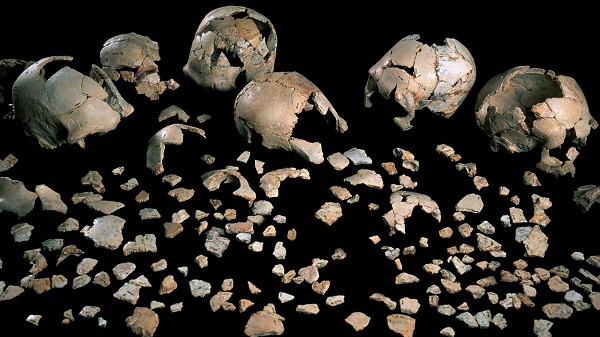
Many hominins once walked the Earth (Credit: Javier Trueba/MSF/SPL)
To start with, it's worth pointing out that extinction is a normal part of evolution. In that sense it may not seem surprising that human-like species – known as "hominins" – have died out.
There is no evidence they were systematically preying on large animals
But it is not obvious that the world only has room for one species of human. Our closest living relatives are the great apes, and there are six species alive today: chimpanzees, bonobos, two species of gorilla and two species of orangutan.
There are some clues that reveal why some of our forebears were more successful than others.
Several million years ago, when a great many hominin species lived side-by-side, they mainly ate plants. "There is no evidence they were systematically preying on large animals," says John Shea of Stony Brook University in New York, US.

The skull of an Australopithecus (Credit: Pascal Goetgheluck/SPL)
But as conditions changed, and hominins moved from the forests and trees to the drier open savannahs, they became increasingly carnivorous.
Until quite recently, we still shared the planet with other early humans
The problem was, the animals they hunted also had fewer plants to eat, so overall there was less food to go around. That competition drove some species extinct.
"As human evolution pushed some members to be more carnivorous, you would expect to see less and less of them," says Shea.
But while the switch to meat-eating clearly took its toll, it did not come close to leaving Earth a one-human planet. Until quite recently, we still shared the planet with other early humans.

Remains of the 'hobbit' (left) have only been discovered on one island. (Credit: Equinox Graphics/SPL)
Rewind to 30,000 years ago. As well as modern humans, three other hominin species were around: the Neanderthals in Europe and western Asia, the Denisovans in Asia, and the "hobbits" from the Indonesian island of Flores.
The Neanderthals were displaced very soon after modern humans encroached on their habitat
The hobbits could have survived until as recently as 18,000 years ago. They may have been wiped out by a large volcanic eruption, according to geological evidence from the area. Living on one small island will also leave a species more vulnerable to extinction when disaster strikes.
We do not know enough about the Denisovans to even ask why they died out. All we have from them is a small finger bone and two teeth.
However, we know a lot more about the Neanderthals, simply because we have known about them for much longer and have many fossils. So to get at why we are the only human species left standing, we must rely on figuring out why they died out.

Gibraltar was home to some of the last Neanderthals (Credit: Natural History Museum/SPL)
The archaeological evidence strongly suggests that the Neanderthals somehow lost out to modern humans, says Jean-Jacques Hublin of the Max Planck Institute for Evolutionary Anthropology in Leipzig, Germany. The Neanderthals were displaced very soon after modern humans encroached on their habitat, which Hublin says can't be a coincidence.
Neanderthals were better adapted to hunting in woodland environments than modern humans
Neanderthals evolved long before us, and lived in Europe well before we arrived. By the time we got to Europe, just over 40,000 years ago, Neanderthals had been successfully living there for over 200,000 years, ample time to adapt to the chilly climate. They wore warm clothes, were formidable hunters and had sophisticated stone tools.
But when Europe began experiencing rapid climate change, some researchers argue, the Neanderthals may have struggled.
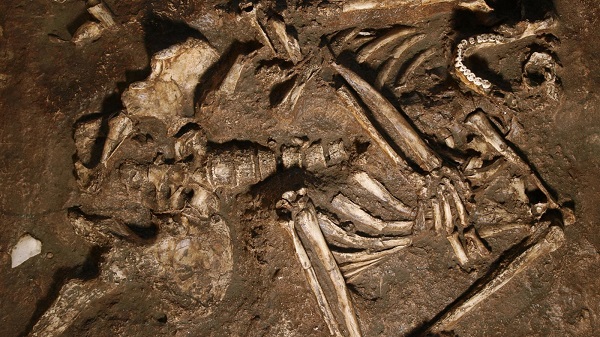
Neanderthals (replica) lived in Europe long before us. (Credit: Javier Trueba/MSF/SPL)
The temperature was not the main issue, says John Stewart of Bournemouth University in the UK. Instead, the colder climate changed the landscape they lived in, and they did not adapt their hunting style to suit it.
Neanderthals were better adapted to hunting in woodland environments than modern humans.
But when Europe's climate began fluctuating, the forests became more open, becoming more like the African savannahs that modern humans were used to. The forests, which provided most of Neanderthals' food, dwindled and could no longer sustain them.
Modern humans also seemed to hunt a greater range of species.

A Neanderthal axe made of shaped flint (Credit: Dirk Wersma/SPL)
As well as large game, they also hunted smaller animals like hares and rabbits.
In contrast, there is little evidence that Neanderthals hunted similar small ground mammals according to analyses of archaeological sites in Iberia where the Neanderthals clung on the longest.
We had a greater range of innovative and deadly tools
Their tools were better suited for hunting bigger animals, so even if they tried, they may not have been successful at catching small animals. Though there is evidence they ate birds, they may have lured them in with the remains of other dead animal carcasses, rather than actively hunting them in the sky.
All in all, "modern humans seemed to have a greater number of things they could do when put under stress," says Stewart. This ability to innovate and adapt may explain why we replaced Neanderthals so quickly.
"Faster innovation leads to better efficiency and exploitation in the environment and therefore a higher reproductive success," says Hublin.
He believes that there is something intrinsic to modern humans that helped us adapt so quickly. There is some evidence for that.
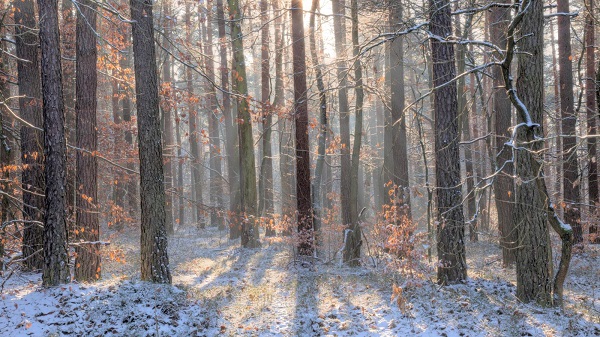
Neanderthals liked hunting in forests (Credit: Julie G. Woodhouse/Alamy)
We know Neanderthal tools were remarkably efficient for the tasks they used them for, but when we arrived into Europe ours were better. The archaeological evidence suggests that we had a greater range of innovative and deadly tools.
But tools are not the only things modern humans made. We also created something else, which helped us outcompete every other species on Earth: symbolic art.
Shortly after modern humans left Africa, there is ample evidence that they were making art. Archaeologists have found ornaments, jewellery, figurative depictions of mythical animals and even musical instruments.
"When modern humans hit the ground [in Europe], their populations went up quickly," says Nicholas Conard at the University of Tübingen in Germany, who has discovered several such relics. As our numbers swelled, we began living in much more complex social units, and needed more sophisticated ways to communicate.
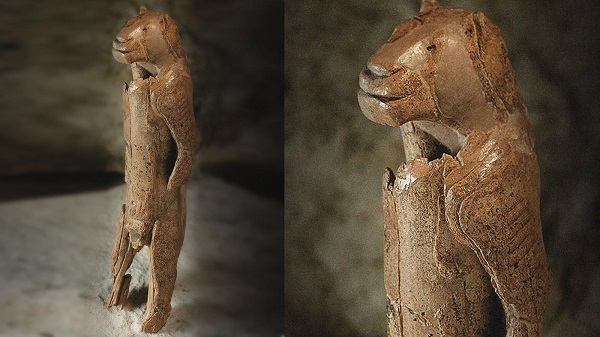
The Lowenmensch is over 30,000 years old. (Credit: Heritage Image Partnership Ltd/Alamy)
By 40,000 years ago, humans in Europe were making things any of us would recognise as art. One of the most striking is a wooden carving of a lion-human statue, called the Löwenmensch, found in a cave in Germany. Similar sculptures from the same period have been found elsewhere in Europe.
They didn't need a whole arsenal of symbolic artefacts to get the job done
This suggests that we were sharing information across cultural groups from different areas, rather than keeping knowledge to ourselves. It seems art was a critical part of our identity, helping to bring different groups together.
In other words, symbols were a kind of social glue. They could "help people organise their social and economic affairs with one another," says Conard.
In stark contrast, Neanderthals didn't seem to need art or symbols. There is limited evidence they made some jewellery, but not to the extent we did. "They did their hunting, cooking, sleeping, eating, sex and recreation. They didn't need a whole arsenal of symbolic artefacts to get the job done."
For humans, the sharing of symbolic information has been crucial to our success. Every new idea we pick up has the chance to become immortal by being passed down through the generations. That is how language spread, for example.
They found a rut and were stuck in it
The fact that we made any art at all, using the same hands that made all those tools, also points to our unique capacity for behavioural variability, says Shea.
"We do everything more than one distinct way," he says. "Often, the solutions we devise for one problem, we can repurpose to solve a different one. This is something we do exclusively well."
Other ancient hominins seemed to do the same thing over and over again. "They found a rut and were stuck in it."
Did we have a superior brain to thank for this?
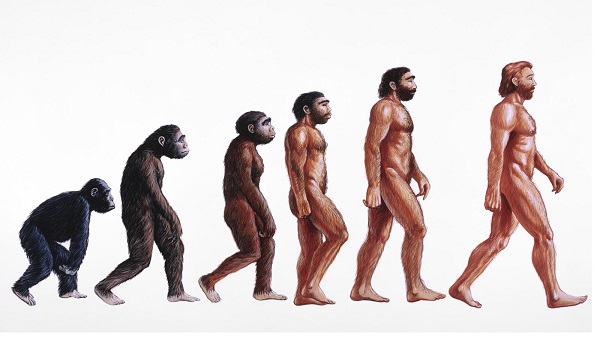
From ape to human (Credit: David Gifford/SPL)
That has long been a popular view. Illustrations of human evolution like the one above often show a progression from ape-like creatures to modern humans, with ever bigger brains as things went on.
Most Europeans only developed a tolerance to lactose when our ancestors started to eat more dairy produce
In reality, our evolutionary story is more complicated than that. Homo erectus survived for a long time and was the first hominin species to expand out of Africa – before even the Neanderthals – but its brain was quite small.
As a result, some anthropologists are uncomfortable with the idea that big brains were the solution. Our big brains may have played a role in our success, but Neanderthals had equally large brains compared to their body size.
Hublin says there is a more refined explanation.
We know that our behaviour, or the circumstances in which we find ourselves, can change our genetic make-up.
There are important differences between us and our Neanderthal and Denisovan relatives
For instance, most Europeans only developed a tolerance to lactose when our ancestors started to eat more dairy produce. Genetic changes can also occur when large populations are faced with devastating diseases such as the Black Death in the 14th Century, which changed the genes of survivors.
In a similar vein, Hublin proposes that modern humans, at some point, benefited from key genetic changes.
For the first 100,000 years of our existence, modern humans behaved much like Neanderthals. then something changed. Our tools became more complex, around the time when we started developing symbolic artefacts.
We now have genetic evidence to suggest that our DNA changed at some point after we split from the common ancestor we shared with Neanderthals.

Neanderthals were not as primitive as once believed. (Credit: Ray Roberts/Alamy)
When peering into our genetic make-up, there are important differences between us and our Neanderthal and Denisovan relatives. Geneticists have identified several dozen points in our genome that are unique to us, and several of them are involved in brain development.
Before we developed these abilities, modern humans and other hominins were fairly evenly matched
This suggests that while Neanderthals may have had a similar brain size to ours, it may have been the way our brains developed over our lifetimes that was key to our success.
We don't know what benefits these genetic changes had. But others have suggested that it is our hyper-social, cooperative brain that sets us apart. From language and culture to war and love, our most distinctively human behaviours all have a social element.
That means it could be our propensity for social living that led to our ability to use symbols and make art.
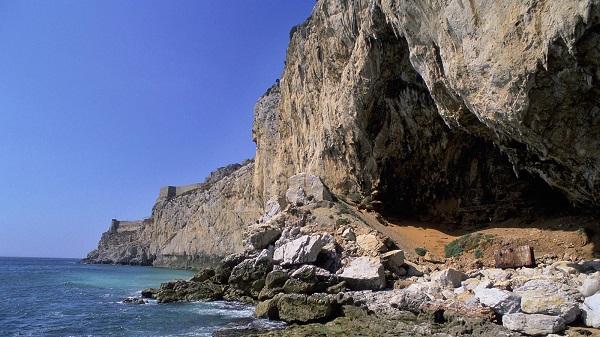 Gorham Cave in Gibraltar, once a Neanderthal colony (Credit: Javier Trueba, MSF/SPL)
Gorham Cave in Gibraltar, once a Neanderthal colony (Credit: Javier Trueba, MSF/SPL)
For tens of thousands of years, before we developed these abilities, modern humans and other hominins were fairly evenly matched, says Conard. Any other species could have taken our place.
But they did not, and eventually we out-competed them. As our population exploded, the other species retreated and eventually disappeared altogether.
If that's true, we might have our creativity to thank for our survival.
But there is one other possibility, which we can't entirely ignore. Maybe it was pure chance. Maybe our species got lucky and survived, while the Neanderthals drew the short straw.
By Melissa Hogenboom
Source: CBS News





